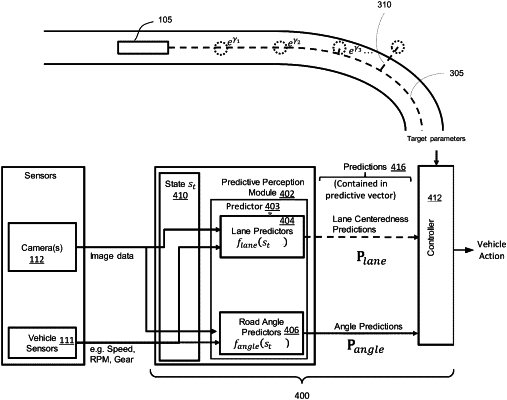| CPC G05D 1/021 (2013.01) [B60W 30/0956 (2013.01); B60W 50/0097 (2013.01)] | 20 Claims |

|
1. A method for predictive control of an autonomous vehicle, the method comprising:
receiving a digital image representing an environment of the autonomous vehicle and vehicle data representing a speed of the vehicle;
determining a current state of the autonomous vehicle and the environment of the autonomous vehicle, the current state being a set of data that includes the digital image and the vehicle data;
generating, using a respective set of lane centeredness general value functions (GVFs), a first set of predictions representing future lane centeredness of the vehicle over a set of respective multiple future time horizons, the first set of predictions being generated by the respective set of lane centeredness GVFs based on only the digital image and the vehicle data in the current state;
generating, using a respective set of road angle GVFs, a second set of predictions representing future road angle of the vehicle over the same or different set of respective multiple future time horizons, the second set of predictions being generated by the respective set of road angle GVFs based on only the digital image and the vehicle data in the current state;
wherein the respective set of lane centeredness GVFs is implemented using at least one neural network and maps the digital image and the vehicle data in the current state to the first set of predictions over the set of respective multiple future time horizons;
wherein the respective set of road angle GVFs is implemented using the same at least one neural network or at least one other neural network and maps the digital image and the vehicle data in the current state to the second set of predictions over the same or different set of respective multiple future time horizons; and
generating, based on the first set of predictions over the set of respective multiple future time horizons and the second set of predictions over the same or different set of respective multiple future time horizons, a vehicle action.
|